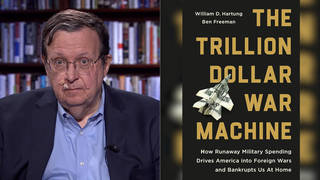
Topics
Guests
- Steven Greenhouselabor and workplace correspondent for the New York Times and author of the new book The Big Squeeze: Tough Times for the American Worker.
A new book by New York Times labor reporter Steven Greenhouse examines how much of the American workforce is working more but earning less. Wages have stagnated, health and pension benefits have grown stingier, and job security has shriveled. Greenhouse joins us to talk about The Big Squeeze: Tough Times for the American Worker. [includes rush transcript]
Transcript
JUAN GONZALEZ: The federal minimum wage increased last week from $5.85 to $6.55. The increase gave nearly two million American workers a raise. The seventy-cent increase is the second of three enacted under a 2007 law that saw the first minimum wage hike in more than a decade.
But, adjusted for inflation, the minimum wage remains lower in real terms than it was forty years ago, despite record corporate profits.
A new book by the New York Times labor reporter Steven Greenhouse examines how much of the American workforce is working more but earning less. Wages have stagnated, health and pension benefits have grown stingier, and job security has shriveled. The book is titled The Big Squeeze: Tough Times for the American Worker.
Steven Greenhouse joins us here in the firehouse studio. Welcome.
STEVEN GREENHOUSE: Nice to be here, Juan.
JUAN GONZALEZ: An amazing book, Steve. You’ve traveled all around America, obviously, as a labor reporter for the New York Times, and you take us into all kinds — not just to factories, but the Silicon Valley jobs, the service jobs, to give us a sense of what is happening to the everyday worker.
STEVEN GREENHOUSE: I — we all love Barbara Ehrenreich’s book Nickel and Dimed, and I felt, I’m going to try building on that. And I really try looking across the board what’s happening to the nation’s workers. I look at, you know, farm workers. I look at Microsoft workers. I look at, you know, factory workers, whose jobs are disappearing to Mexico. And I look at, you know, software engineers at Hewlett-Packard, at some other places, you know, that have lost their jobs to India. I look at janitors in Houston who — I focus on one janitor in Houston, who, after ten years, is making just $5.25 an hour. I write about a Dominican worker in Brooklyn who works eleven hours a day for just $35 a day. You know, the whole panoply of what’s happening, to show that there’s this big squeeze on the nation’s workers, where, as you were just saying, wages have been flat, health and pension benefits are getting worse, at the same time corporate profits have gone up very, very nicely. Employee productivity has gone up 15, 20 percent, yet wages have been flat, plus companies are pressuring workers, you know, to work harder and harder.
JUAN GONZALEZ: The health insurance situation, I think you had a starting story about one worker, a security guard, who had caught many shoplifters at his store. He hurts himself in the process of capturing one of them or arresting one of them and then ends up being fired, because now he requires medical treatment that his employers don’t want to give him. The impact of the health insurance crisis on America’s workers?
STEVEN GREENHOUSE: It’s — I write about this worker, Mike Michell, who works as security guard for a Wal-Mart in Texas, and he was a great security guard. He caught 180 shoplifters over a two-year period. One day, he runs out into the parking lot to chase after someone who’s using stolen checks. The woman’s accomplice floors the accelerator, hits Mike, you know, messes up his back, breaks his kneecap. You know, Mike asks for a few weeks off, because he needs surgery on his knee. He applies for workers’ comp, and boom, he’s fired. And this shows how companies sometimes retaliate against people who file for workers’ comp.
And that’s part of a broader health crisis in the nation, where, since the year 2000, even though we’ve had pretty good economic times until the last few months, nine million more Americans are out of work than was the case in 2000. So now, almost 50 million Americans, nearly one-sixth of the workforce, is uninsured. And you think how crazy that is, in ways. You know, we’re the world’s wealthiest nation, yet one-in-six workers are out of work.
And another, you know, health statistic that surprised me when I was researching the book was, United States spends about $6,500 per person for health coverage, which is more than twice what France and Germany spent, about two-and-a-half times what Japan spent, yet, you know, they have universal health coverage. They have longer life spans than Americans. Yet, you know, we spend twice as much, and one-in-six people are uninsured. So something is badly broken in the health system.
JUAN GONZALEZ: Now, given the record corporate profits that we’ve seen and the relative prosperity of so many American companies over recent decades, why do we have this continuing spiral downward, in terms of the living standard of the average worker?
STEVEN GREENHOUSE: You know, if there’s any one theme in my book, Juan, it’s that things are out of whack, out of balance in the workplace, that corporate profits have hit record levels, employee productivity has really zoomed upward 15, 20 percent over the past six, seven years, yet, you know, wages have gone nowhere. You know, corporate profits, as a percentage of overall national income, have hit record levels, and wages, as a percentage of income, national income, have fallen to the lowest level since basically the Depression.
So, what’s wrong here? That’s a good question. I think part of it is that employees unions have much less bargaining power, much less power vis-a-vis corporations than was the case thirty, forty, fifty years ago. Part of that is weaker unions. Part of that is globalization has really increased corporate power over workers, because corporations can tell employees, “Look, if you don’t accept a wage freeze, we’ll just move your job to China or India. If you’re too vocal in demanding wage increases, raises, well, maybe you’ll be caught up in the next round of downsizing.” So I think globalization has really enabled corporations to increase pressure.
And another thing, Juan, is, you know, Wall Street — I think Wall Street, since the 1980s and the rise of the institutional investor, the rise of mutual funds, hedge funds, pension funds, Wall Street is exerting much more pressure on corporations to maximize their share prices, as you know, which means maximize profits, which often translates into lowering costs and especially lowering payroll costs. So a lot of managers will say, you know, the area where they have most flexibility to reduce cost and increase profits is on payroll. So that’s why we’re seeing all these waves of downsizing.
JUAN GONZALEZ: You know, one of the things that I’ve often wondered about, especially over the last twenty years, is — as we’ve both covered the labor movement for many years — is that the impact of the lack of alternatives on the world scale, that it seems that during the period when there were a considerable number of socialist countries in the world, for all their problems that these countries had, they at least provided an alternative vision of the kind of society — how workers would be treated. And as a result, the capitalist countries almost had to provide more benefits to their workers to prevent them from trying to institute a socialist society, so that, in essence, once the socialist camp collapsed, really the Western capitalists felt that pretty much, hey, we don’t have to worry about our workers taking any other roads, so we can do whatever we want with them. It seems to me that, in some degree, one benefit to us in the United States and Europe by the existence of the Soviet Union and China, all these others, was that the governments had to be more careful about how they treated their workers. Any thoughts on that?
STEVEN GREENHOUSE: I kind of saw there are three camps. There’s like the American, you know, almost extreme free market model. There was the western European kind of social democracy model. And then there was the socialist-communist model of China, Russia. So that model has kind of fallen — the lesson has kind of fallen by the wayside, but I still think, you know, there’s a very strong western European model, which still remains quite different from the American model. And you speak to a lot of, you know, union people here, liberals here, progressives here, they say, “Well, we should have a lot more what western Europe has.”
You know, in researching the book, I was kind of surprised, even shocked, that the United States is the only industrial nation without universal health coverage. We’re the only industrial nation without – actually, one of the very few nations in the world, one of four nations of the world, without paid maternity leave. We’re the only industrialized nation without a law saying everyone gets x number of vacation days. In the European Union, the twenty-seven nations, every worker is guaranteed four weeks’ vacation. And also, we’re the only industrialized nation where workers are not by law guaranteed a set number of paid sick days. So, you know, I think we still have a lot to learn from the so-called social democracies of Europe, in terms of their model versus our model.
JUAN GONZALEZ: And hopefully they will last long enough for us to learn from them. Let me ask you about our labor movement. Obviously, a few years back, there was a big battle and division within the American labor movement between the AFL-CIO and the establishment of a new Change to Win coalition, led by the SEIU and others, but that coalition really hasn’t appeared to have had much of an impact on the overall direction that the labor movement is going in. What’s your sense of how this is shaking out, this split in the American — in organized labor?
STEVEN GREENHOUSE: The unions that quit the AFL-CIO – the Service Employees, the UNITE HERE apparel hotel workers, the Teamsters, the United Food and Commercial Workers —- they say they needed, they wanted to leave the AFL-CIO to give them an opportunity to grow faster and mobilize more. I think you’re right, Juan. We haven’t yet seen real big changes in how much these unions have been organizing. The Service Employees were organizing, you know, more workers than any other union before the split; they continue to organize more than any other union. UNITE HERE was doing a lot of organizing before the split; it still is. But some of the unions in Change to Win that weren’t doing much organizing before, like the Teamsters, like United Food and Commercial Workers, unfortunately they’re still not doing much organizing. We keep hearing that Change to Win is working very hard with these unions to turn things around.
You know, in the book, I write about one kind of Change to Win or Service Employees organizing drive that does hold out a lot of hope for the labor movement. I write about the Service Employees’ effort to unionize 5,300 janitors in Houston, and the workers there really had it bad. I mention, you know, this worker who worked ten years as a janitor at a luxury office building, where, after ten years, she was still making $5.25 an hour, and she was an immigrant from El Salvador, refugee from El Salvador. And so, she got involved in this unionization drive. And, you know, the workers, these 5,300 janitors, virtually all of them were immigrants, virtually none of them spoke English. Many of them were undocumenteds. They were all part-time. They were all subcontract—- I mean, a very, very, very hard population to organize and, to boot, in a state that’s one of the most — Texas, one of the most anti-union in the nation.
And the Service Employees were able to unionize them using some very smart tactics that I describe in detail. And as a result of the contract, the workers’ wages rise, you know, 60 percent over three years, they go from twenty hours a week to thirty hours a week, so, in effect, their wages double in three years, plus they get health insurance. And I think that’s a wonderful model of how unions can still do important work in helping low-wage workers. You know, could they have done that before this split? Yes. I don’t know if the split really was needed to do that.
JUAN GONZALEZ: We’re talking with Steve Greenhouse, the labor reporter for the New York Times, and he’s written the new book The Big Squeeze: Tough Times for the American Worker. In talking about the SEIU, which is obviously the — I guess the preeminent union right now in the United States, certainly the fastest-growing and most politically influential, they’ve had their troubles, too, in recent years, because as they’ve grown, there’s also been criticism that they’ve become increasingly — sort of making arrangements or deals with companies or with political leaderships in order to get what they call a card check or neutrality agreements to bring in thousands and thousands of workers at one time, but that some are criticizing them for being too much of a top-down organization, rather than practicing sort of the rank-and-file democracy that unions have long espoused, at least in theory. Your sense of how this — these internal conflicts among the reformers in the labor movement are shaking out now?
STEVEN GREENHOUSE: There are — the Service Employees, I agree, Juan, are the fastest-growing union in the nation. I often think of the phrase about Reggie Jackson of the Yankees: they’re the rod that stirs the drink in the labor movement. They’re really, you know, kicking ass in many ways. They’re doing a lot.
And — but there’s a big debate within the union, that, you know, Andy Stern, you know, the leader, who is in many ways the most visionary leader in the labor movement — you know, people say, “Oh, he’s too top-down. He doesn’t listen enough to what’s happening at the grassroots.” And Stern — and he’s having a big fight with the head of the union’s biggest healthcare union in California, headed by Sal Rosselli. But Stern says, you know, “I’m pushing ahead. You know, we’re doing what’s needed to grow, and we have a good vision. And, you know, come along with us.” And as in any big institution, there are frictions. And as you say, Juan, you know, they have made some pragmatic choices that they’ll give perhaps some concessions on wages with a company to persuade that company to make it easier to allow card check when SEIU is trying to organize some of their non-union operations in other states. So there’s a big debate about how much — how many concessions should one make in order to get organizing rights to make it easier to organize non-union workers who have it worse than those, you know, who already are unionized.
JUAN GONZALEZ: One of the things that struck me in your book was when you talk about the companies that actually treat their workers well, which you mention Costco and some other companies, and it might come as a surprise to those of us who continue to labor under less-than-ideal conditions in our workplaces. Can you talk about those companies and how they came to the philosophy that they pursue in their business?
STEVEN GREENHOUSE: Sure. In the book, I write about a lot of things, wrong things, a company is doing. You know, and I have chapter after chapter about companies that make people work off the clock, or managers that erase hours from people’s time cards, or companies that horribly exploit undocumented workers.
But I thought it would be important to show that there are some, even a lot of, companies that do the right thing, that treat their workers very well. And at Costco — and I have a long section about Costco — the founder, Jim Senegal, son of a Pennsylvanian who was a coal miner and a steel worker and a good union man, you know, Senegal had this vision that “I’m going to treat my workers well. I’m going to have very low prices. I don’t want anyone thinking that I have low prices because our workers work under sweatshop conditions, though.” He decided, in setting up Costco, that Costco would have the best wages and benefits of any retailer, general retailer, in the nation. And —-
JUAN GONZALEZ: And does it?
STEVEN GREENHOUSE: Generally, it does, yes. Someone working at Costco for, say, five years, their wages and benefit package together will be two, two-and-a-half times what the wage and benefit package is together at Wal-Mart. You know, the health plan is extremely good.
There’s this funny story about Costco, where each year they do a survey of their workers, saying, “What’s the best thing about working at Costco? What’s the worst thing about working at Costco?” And one poll found that employees said the worst thing about working at Costco is they weren’t allowed to wear shorts to work year round. So, imagine if that were the biggest complaint at every company in the United States.
And, you know, Costco is a direct rival of Wal-Mart. You know, they’re competing for the same shoppers who want discounts. Yet Costco’s vision is, if you pay your workers well, if you treat them well, they’ll be loyal to you, they’ll be very productive, and they’ll smile to customers. And, you know, you want your customers to like you when they shop at your place.
JUAN GONZALEZ: And you say the CEO has been under a lot of pressure from Wall Street to change those conditions?
STEVEN GREENHOUSE: Well, there are folks on Wall Street who say, you know, “Senegal, your prices are too low. You should raise your prices. Your wages are too high. You could increase your profits by decreasing, you know, by holding down, by freezing your wages, by reducing your generous health benefits.” And he sticks to his guns, and he says, “That’s my vision, and that’s what we’re going to do.”
JUAN GONZALEZ: And some of the other companies that you mention there?
STEVEN GREENHOUSE: I write about Ernst & Young, you know, in Midtown Manhattan. I interviewed the former chairman of Ernst & Young, who said, “You know, when I was growing up, all the smartest girls in high school, all the smartest young women in -— all the smartest people in college were women.” And then he said, when he went to work at Ernst & Young, you know, half the people hired were women, and they were the best workers, yet he was dismayed, he was shocked, that only five percent of Ernst & Young’s partners were women. So he said he was going to change that. So Ernst & Young has really — you know, he realized that the reason so many women were leaving in droves was that the job was too demanding. It made it nearly impossible to balance job and family. So he really developed — Ernst & Young has really developed this wonderful flex-time model that other companies should seek to emulate, I think. You know, workers, female workers, male workers, if they want, they could decide to just work three days a week or just four days a week, and as long as you work more than twenty hours a week, you still get full benefits. People can work, you know, seventy hours a week in the months before tax time, and then they could take the summer off.
I write about Patagonia, another wonderful company that believes in serious flex time. Patagonia in Ventura, California, right along the Pacific, kind of encourages its workers to go surfing at lunchtime. And they — you know, I interviewed some workers. They go surfing for two hours at lunchtime. And, you know, you think many companies would think, “That’s outrageous. How are you going to get your work done?” But Patagonia trusts its employees to use their flex time. You know, maybe they’ll finish working a project at home at night.
JUAN GONZALEZ: Well, in terms of what needs to be done to change the trend now, in terms of the treatment of American workers, if you had to single out one or two key turnarounds that the country needs, what would they be?
STEVEN GREENHOUSE: Very quickly, I think — we’ve lost one-fifth of our manufacturing jobs since the year 2000, 3.5 million jobs, generally, you know, good middle-class jobs with very good benefits. The nation, by and large, has paid way too little attention about strengthening its manufacturing sector. And I think it’s important to do that. One way to do it is put greater focus on green jobs, which can be manufacturing jobs making solar panels, making hybrid cars.
A second thing, I think the nation, by and large, hasn’t paid enough respect to workers as workers. You know, all the attention is about, you know, the Bill Gateses, the Warren Buffetts, the A-Rods, the Paris Hiltons, and not enough about workers. I think workers, in many ways, have become invisible as workers. They’re seen as Bud drinkers or Oprah watchers, but they’re not really seen as workers who, you know, bust their derrieres day in and day out, you know, making the trains run on time, you know, cleaning hotel rooms. And I think if the news media or if politicians really started paying more attention, more respect to workers, that might discourage corporations’ CEOs from squeezing their workers so much.
A third very quick thing is, you know, I think universal health coverage is very important, because whether you’re working, you’re constantly forking over more money each year for health premiums, or if you’re laid off, you know, you’re in the same position, that you, your spouse, your kids might lose health insurance. So I think universal health insurance is key to making life less insecure for workers.
JUAN GONZALEZ: And we’ve got about thirty seconds. How many labor reporters are there in American newspapers these days? Are you the last one? Are you the last one?
STEVEN GREENHOUSE: Well, you do a wonderful job for the Daily News, and you beat me on too many stories. I’m embarrassed to talk about that. The Wall Street Journal has a good young labor reporter. You know, Steve Franklin at the Chicago Tribune is a terrific labor reporter. He’s done a lot of great stuff about immigrant workers. But it’s a very small group. The LA Times no longer has a labor reporter, and the Washington Post really no longer has one, and it’s sad. I want more competition in this business.
JUAN GONZALEZ: More competition, right. OK, I want to thank you, Steve Greenhouse. The book is The Big Squeeze: Tough Times for the American Worker. Former — I mean, continuing labor reporter for the New York Times, Steve Greenhouse.












Media Options